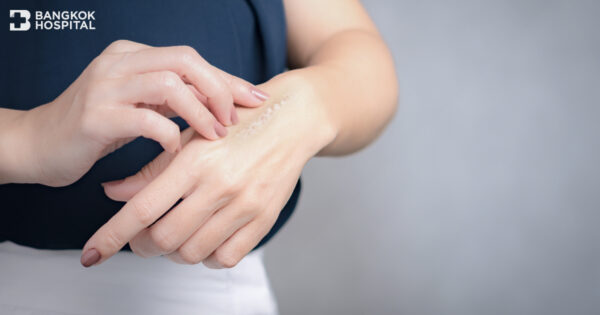Scar problems are always troublesome, especially if they are large, thick, and raised in visible areas, it can significantly undermine confidence in daily life. Scar revision surgery (Scar Revision) is therefore an interesting option to reduce the appearance of scars and restore confidence once again.
Understanding Scars
Scars are the marks left after a wound has fully healed. If a scar aligns with the natural skin folds, it can become less noticeable as it blends in. Consequently, scars from accidents tend to be more apparent than those from surgical procedures
Types of Scars
Scars with issues can be categorized by their characteristics, including:
- Raised scars often result from 2 conditions, namely
- Keloid scars (Keloid) are excessively raised beyond the original wound boundaries, itchy, often developing on the chestfrom heart surgery, on the chest from acne, on the shoulders fromvaccinations, behind the ears from piercings, or elsewhere, with a genetic component
- Hypertrophic scars (Hypertrophic Scar) arise from the body’s healing response . These scars remain within the boundaries of the original wound
- Pitted scars
- Scars that spread wider than the original stitch line
- Contracture scars (Scar Contracture) especially when connecting across joints
- Tight scars
Scar Treatment Methods
There are various ways to treat scars, including:
- Steroid injections for scars involve injecting steroids into the scar tissue to soften and reduce it in size, and to relieve itching and reduce the bumpiness of the scar Typically, injections are spaced apart 2 – 4 weeks and continue until the scar diminishes as cessation may result in the reformation of the scar. Follow-up appointments are then scheduled every 2 – 3 months A common issue post-injection is thinning of the skin and fat collapse, which is difficult to correct. Careful consideration of the drug dosage and needle placement is important, and individual responses to the treatment mean that injections should be performed by a specialist
- Laser treatment (Vbeam or Pulsed Dye Laser Treatment) to reduce redness and diminish blood vessels in the area treated
- Scar revision surgery (Scar Revision) involves the following steps
- Completely remove the scar and restitch, resulting in a new, finer line without spread
- Partially remove the problematic area, restitch it, and once healed, cut away the remaining scar tissue in further sessions or treat with steroid injections. This is often used for very large scars that cannot be removed in one procedure.
- For scars in taut areas, change the stitching direction to lessen the tightness.
Risks and Side Effects
- General risks
- Pain at the scar site, which can be mitigated with painkillers
- Specific risks
- The scar may widen or raise again after healing. Typically, the outcome is better when corrected by a specialist as they use techniques to reduce tension and possibly alter the direction to decrease the tautness of the scar
Preparing for Scar Revision Surgery
- Inform the doctor about health problems, severe diseases, chronic conditions, prior surgeries, anesthesia history, dental issues, including loose or false teeth, as well as any allergies to medications, food, or other substances
- Patients with risk factors or chronic illnesses may need to undergo physical preparations such as X-rays, blood tests, electrocardiograms, or consultations with medical specialists to ensure readiness for surgery and anesthesia
- Avoid certain medications, supplements, and herbs which may affect surgery outcomes such as pain relievers, aspirin, vitamin D, vitamin C, and fish oil at least 7 days before surgery. Bring any medications or herbal supplements to the hospital on the day of surgery
- Quit smoking approximately 1 – 2 weeks before surgery to prevent compromised blood flow to tissues, leading to tissue death. If a heavy smoker, inform the doctor and abstain from smoking at least 1 – 2 weeks post-surgery
- Stop alcohol consumption within 24 hours before surgery and abstain for at least 1 week post-surgery
- Shower and wash hair to ensure cleanliness, and do not use cosmetics
- Fast from food and water according to doctor’s instructions to prevent aspiration of stomach contents or food particles into the lungs during anesthesia. This also aids in recovery from anesthesia

Post-operation Scar Care
- Avoid exposing the scar to the sun after sutures are removed 1 month, or use sunscreen with SPF of 50 or higher on the scar area
- For areas with significant movement, such as around the mouth, use a plaster to secure the area, preventing the scar from stretching
- If swelling, redness, or warmth occurs at the surgical site, consult the doctor for follow-up
- The timing for suture removal is at the doctor’s discretion, facial areas 5 days, and arms, torso, and legs 7 – 10 days
Treating scars may require a combination of approximately 2 – 3 different methods for best results, as generally no single treatment is 100% effective. Particularly with scar revision surgery, it’s crucial to consult a specialist in detail to ensure proper treatment and satisfactory outcomes.









